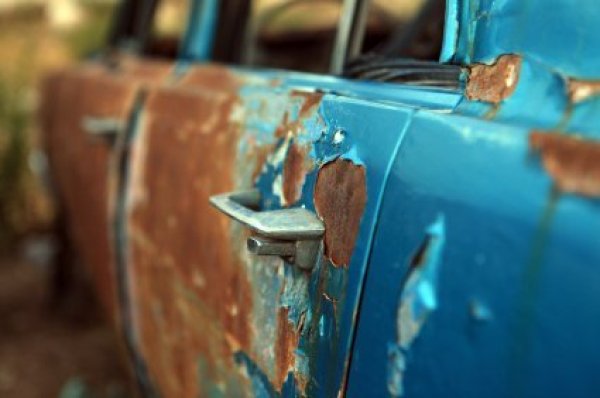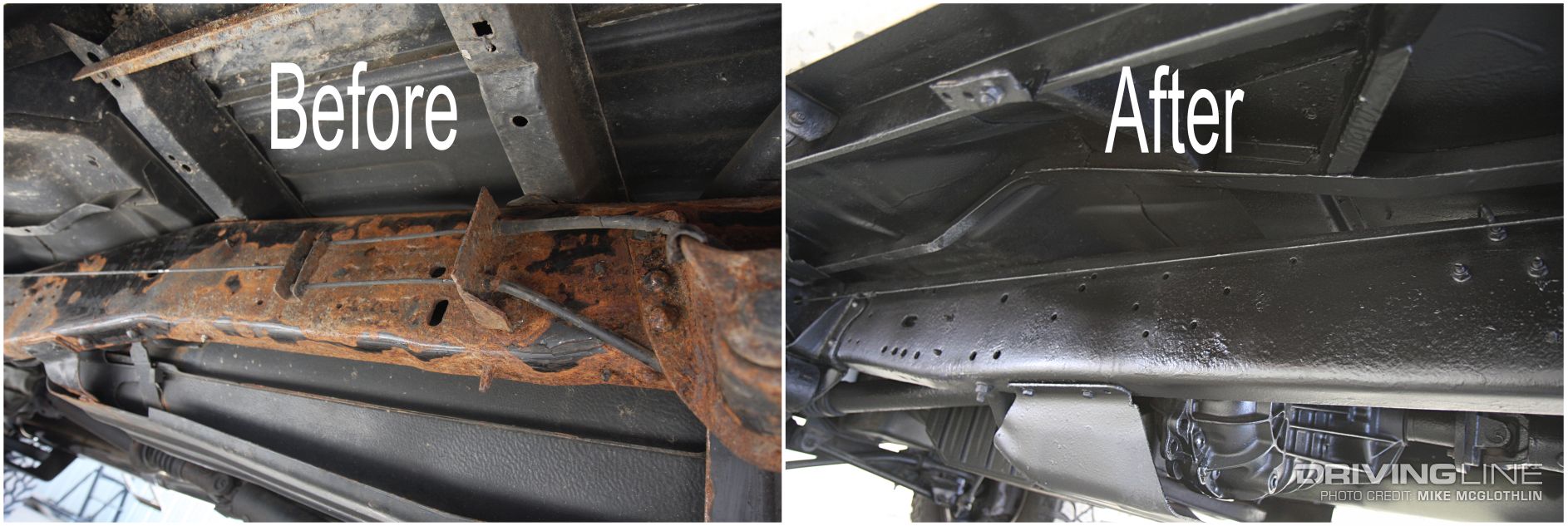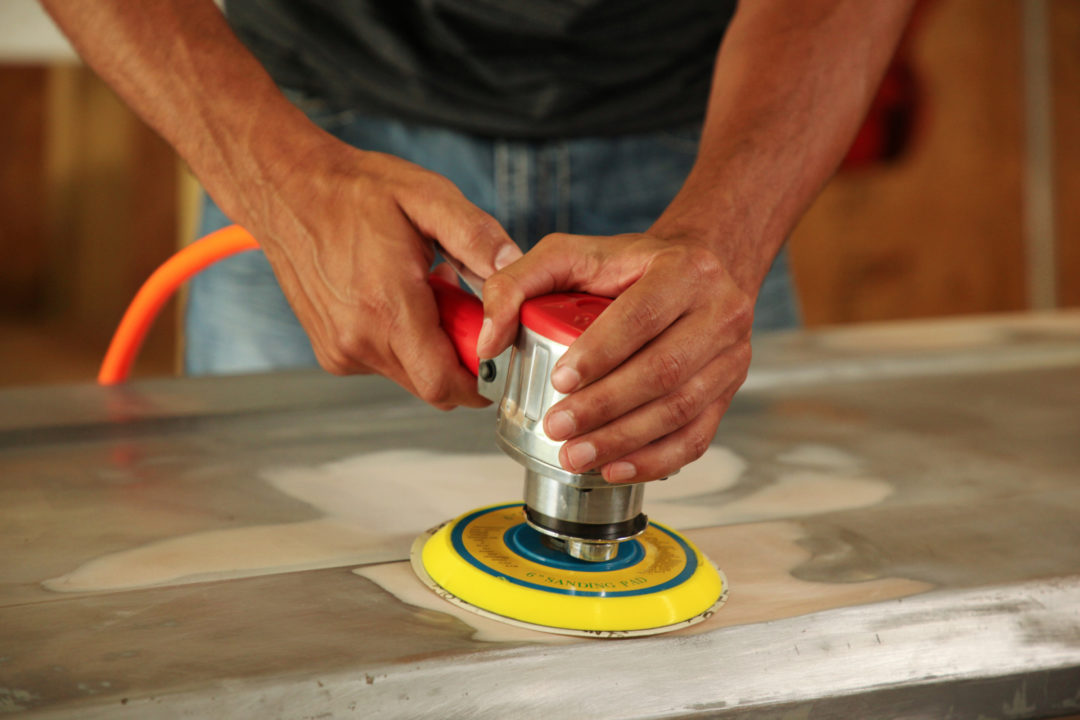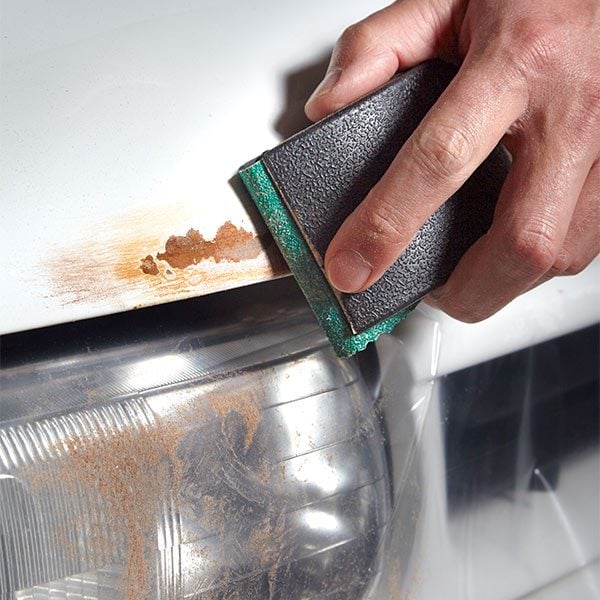Whether you own a new or old car, protecting the underbody against water ingress from surface water during harsh weather conditions is an important part of vehicle maintenance. Also, did you know that rock salt used to clear roads from snow and ice is a corrosion accelerant when introduced into the iron oxide chemical reaction? This means rust proofing your car every couple of years is a good idea due to the increased risk with flooding in the UK. Applying a suitable car rust protection coating will help to prevent rusting, by forming a protective film barrier to stop oxygen reacting with the metal. Helping you to reduce maintenance costs and avoid the premature replacement of components and parts. 2) When applying a underbody rust proofing coating, preparing the surface is very important to ensure all dirt and soiling has been removed.
For this process, we recommend using a steam pressure washer and suitable cleaner & degreaser that will remove any surface salts already present. However, you must wait until the surface is completely dry before proceeding to apply the underbody rust proofing coating. Otherwise, surface moisture can become trapped underneath the chassis underbody rust proofing protective layer that will soon start rusting. With newer cars you will also need to remove all plastic underbody protective tray covers from around the chassis area and wheel arches prior to steam cleaning. 1) Before applying the car underbody rust proofing coating, you must prepare the work area and ideally spray the product in a clean environment. We also recommend masking the vehicle and treatment area to prevent overspray.
You must also wear a ventilator or dusk mask and only apply the underbody car rust protection coatings in a well-ventilated room. Finally, it's advisable to apply the car underbody rust proofing treatment on a day with low humidity for faster drying times. Protecting your car from rust can help you to avoid unnecessary costly repairs or scrapping your vehicle in extreme circumstances. This problem soon leads to iron oxide 'rust' forming on the surface, a chemical reaction caused by oxygen and water or moisture in the air. If you're skilled enough – and daring enough – you might be able to tackle surface rust and small rust spots. First, use fine-grit sandpaper or a razor blade to remove the rust.
Then treat it with a spray-on rust inhibitor and apply primer. Finally, cover it with touch-up paint that matches the color of your vehicle. Touch-up paint is available from dealers, auto parts stores, and automotive paint suppliers. Rust begins to peel off after a stage called primary oxidation, which has become more advanced, and blisters result, which will peel off to reveal more metal surfaces. And so, the process continues throughout your car if you leave it untreated.
To combat car rust and stop it from creeping or developing, use a wire brush to remove rust from the car, then scrub the surface with a grinding wheel. In the final stage, apply a primer and a coat of paint that matches the car's color on the area until this area is completely treated. Spray the filler primer in heavier coats to cover the entire repair area. Move the can away from the surface slightly and blend it into the surrounding painted area. Self-etching epoxy primer provides a strong bond to bare metal, so use it as your first coat. Spray two to three medium coats, allowing the recommended wait time listed on the label between coats.
Wait a full hour for the epoxy to dry to the touch (longer if it's humid outside). Wipe the dried epoxy primer with a lint-free cloth and apply two to three heavier coats of lacquer filler primer allowing drying time between each coat. Let the lacquer primer dry until it's dry to the touch-at least one hour-before sanding.
To remove rust from a car, you'll need to get a sander and a grinder, along with safety gear, like gloves, goggles and a mask, to protect yourself from rust and paint particles. Then, cover any parts of the car you're not working on with paper and masking tape before you sand off the paint around the rust. Next, use the grinder to remove the rust, then fill any spaces where you've sanded off the paint with a body filler. After that, apply 3 coats of primer, sand with wet sandpaper, and cover the area with as many coats of paint as necessary to get the right color and finish. Keeping your car's body pristine and lustrous through its life not only reflects your care but is a matter of immense pride for your car. However, our cars are made of metal and one process that takes a toll on our car's appearance is rust.
How To Make A Rusty Car Look Better While today's cars come with many rust protection coatings on the exterior surface, some areas of the car are still prone to rusting. From the wheel wells to the undercarriage, rust is an enemy that not only damages the car's appearance but also reduces the structural integrity of the car. This is everything you need to know about causes of rust, its types, the preventive anti-rust measures you should take, and how to remove rust if it is already on your car. 5) Once you have successfully applied the car rust proofing coating, it's advisable to repeat the process every couple of years to ensure the underbody chassis remains protected.
You should also conduct regular inspections for any cracks or evident holes appearing in the underbody protective coating layer. In most cases conducting simple minor repairs to the car rust proofing protective layer is quick and easy with an aerosol spray application. When compared to other leading underbody rust proofing paints that peel, crack, chip, scratch or flake far sooner to enable rusting.
Once sprayed or brushed onto vehicle underbody surfaces the rust prevention paint forms a rock hard non-porous flexible protective coating. This makes POR 15 an ideal solution for protecting the vehicle suspension and chassis area. Then sand the rust using 40-grit sandpaper, sanding through the rust spots, down to bare metal.
Then enlarge the sanded area so you'll have space to feather the edges. Use a tack rag to remove particles from the unmasked area. If the rust has created pits in the metal you can fill them now with body filler or wait until the epoxy primer dries and apply multiple coats of filler primer. It's fairly aggravating to attempt to repair a rusted vehicle but especially when it's a repeat offender. Performing rust repair requires some basic knowledge and judgment to make sure that the rust doesn't have a chance to return. However, when the repair is done sloppily or with little know-how, oftentimes, you'll see this car get more rust not long after.
There's no point in sanding out the rusted spots if you're not going to inspect the entire car for rust and make sure to get rid of each speck. If you're only going to spot-treat the most superficial sign of rust, then you'll be heavily dismayed at the rusty backlash to come. What's worse is when too much of the fiberglass filler is used. If you're filling in holes that are a half-inch thick, then you may want to reconsider swapping out the entire panel. Every situation is slightly different, although make sure that there's not too much filler; there's a much higher likelihood of returning rust if a lot is used.
1) Remove Paint and Rust- Use an angle grinder with flapper wheel to remove the old rust and paint from the surface to be repaired. It is possible to accomplish the same thing by hand with coarse 80 grit sandpaper and a wire brush, but it is much harder to do a thorough job. For an area where you can't reach with the grinder, use the wire brush to remove as much dirt, grime, and rust as you can. You may want to use a rust converter, which goes beyond paint to chemically neutralise rust and leave a protective black coating. This phase represents the most advanced car rusting level.
The pin holes from the second stage have penetrated through the panels and metal frames. Because penetrating rust eats through the metallic components, repairing the damage often requires replacing the entire portion or body panel. The best way to avoid the costly repairs caused by penetrating rust is to prevent, catch, and repair surface rust early enough. As noted earlier, many vehicles have a thick coating on the underside that chemically seals the steel against oxidizing agents.
Regular inspection and repair of the spots that have worn bare will keep rust from advancing and causing additional damage. If this coating is not there, consider adding one yourself. As with other rust repairs, sand off any rust that might be sticking through and rough up the area you intend to paint with some sandpaper, then brush or spray the new coating on. Applying a car rust protection underbody chassis coating is simple and can be conducted with a DIY application.
However, preparation is key to ensure the underbody coating is correctly applied and providing the best protection possible for your vehicle. Whilst the car rust proofing process is relatively straightforward and simple, we recommend following the steps below and product application advice guide. A black coloured bitumen compound paste that additionally provides road noise sound deadening. The moisture-repellent rubbery underbody car rust protection coating retains good elasticity for a long time irrespective of temperature conditions.
This product is easy to apply with a paintbrush or spray equipment however, a 3-6mm layer thickness must be achieved to protect the chassis against de-icing salts. Starting as a small bubble under your vehicle's exterior paint, rust can progress and develop into irreversible issues, leading to premature scrappage. Despite the advanced chemical processing that goes into modern paints, no material is entirely resistant to rusting. One of the most frustrating aspects of rust damage is that it's often too late by the time you notice it.
While a rusty wheel or car door can be spotted easily, undercarriage or engine rust is much more difficult to find. What's more, a rusted chassis or engine is dangerous and can contribute to very costly repairs. Although no car is immune to rust, it doesn't mean that rust is inevitable. Understanding why your car is rusting and its causes can help you prevent unnecessary corrosive damage to your vehicle. Preserve one of your most valuable assets by learning how to stop rust on a car. Rust is the chemical reaction between water, oxygen and metals, such as iron, so you can see how it might happen pretty easily to a car in the wild.
While steel — made up mostly of iron — is a very strong material, it can literally crumble between your fingers as rust if left unprotected. Corrosive chemicals such as road salt speed up the process, so vehicles in cold and humid climates are especially prone to rust. But so are habitually dirty vehicles, since mud tends to hold moisture against the metal components. Rust neutralization is a method adopted by automotive detailers and DIY repair experts before performing car paint and waxing. Neutralizing rust on your car basically means removing corrosion from the car.
The next step is to finally prime the car metal surface, apply car paint, add a clear coat, apply wax, and buff it to eliminate any blemishes. Regardless, it's best to correct surface rust as soon as you see it—just in case. That patina-coated truck from Arizona may become a hole-filled nightmare in the wrong weather. Start by using an abrasive wheel or sandpaper (we used 50-grit) to cut through the paint and corrosion until clean, bright metal is visible. Rough up the surrounding areas, too, so that your body treatments can adhere well to the car.
Applying this fast-drying underbody rust proofing product coating is very easy and creates a chemical resistant protective layer. Please note when spraying Eastwood 2k ceramic black chassis underbody coating, professional breathing apparatus must be worn. We also recommend spraying the underbody coating over Eastwood's epoxy primer for increased durability. Classic cars that have been around for decades tend to catch rust a lot faster than newer cars – hence requiring more maintenance. The key to stopping rust is to address the issue early on. If the brownish stains aren't removed on time, they can retire your car to the scrap yard early.
One of the easiest preventive steps is simply washing and waxing your car regularly to help protect it from the elements. Pay special attention to the undercarriage, especially if you live in an area where salt is used on the roads in the winter. Spending a few extra dollars at your local carwash for the undercarriage wash and treatment will go a long way toward preserving your car. You may also want to consider an undercoating for a more permanent solution.
Also, keep an eye out for any small dings that might break the protective layer of paint and touch them up asap. Any moisture in your car gives rust an opportunity to develop. Surface rust is mostly formed when your car's paint breaks down over time. This can be due to mechanical damage or simply too much exposure to the sun's UV rays over time.
Believe it or not, it is actually incredibly easy to be rid of surface rust, however, it may take time and money. The trick is essentially to do the same thing you do when you want to paint or repaint your car. Use some sort of abrasive wheel tool or high-grade sandpaper to remove the paint and the corrosion itself until you get to the clean and bright metal. To remove surface rust, simply spray it on the rusted surface, leave it for around ten minutes and let it get to work on the surface rust. Once it's loosened, it can be scrubbed away easily with a light abrasive on surfaces without paint. You can avoid further damage to the paint by masking the surface while you work on the rust.
And because WD-40 also protects against corrosion, it gives great temporary rust protection too. The metal surface may still be rough once you're done sanding the larger flakes off. If it's in a more visible spot, you may want to consider smoothing it out with a body filler such as Bondo before finishing it out with primer and paint.
Follow the instructions from the manufacturer of the body filler as it can vary, but generally speaking, you mix it up to a specified ratio depending on your room temperature. NAPA recommends only mixing as much body filler as you'll use within ten minutes as it starts to harden relatively quickly. Spread it on using a metal or plastic spreader, but leave a little extra on top to sand smooth.
Spray equipment 'undercoating gun' attached to an air compressor when seeking to achieve a professional finish. When applying to the surface we recommend layering the material to gradually build up the coating until the product manufacturer's recommended thickness has been achieved. Not applying the correct thickness can soon lead to the car rust proofing coating prematurely failing with visible cracks soon appearing due to being very thin. Once rust takes up residence in your car's body, you begin to spot the unforgiving bubbles peaking from the edges of fenders among other hiding places. Like most chemical processes, rusting can be halted in its tracks.
How long an owner procrastinates to do so determines how much permanent damage will be done to the car. Some even say that rust-proofing can help slow the development of rust. However, the best way to eliminate any more from spreading is to cut out all rusted areas, using sandpaper or a wire brush. Most modern-day cars are engineered with extensive anti-rusting measures. These include clear-coat finishes that protect both paint jobs and body panels, as well as galvanized coatings that shield a vehicle's steel body structure. Ensure that the surface to be painted is smooth, dust free, and dry, then carefully apply the paint in a thin, even layer.
Avoid painting too thickly or letting the paint drip and let it dry before sanding with 400 grit paper. Repeat the process twice more for three coats of paint and finish with a wet sand using water and sandpaper. You can clean the paint off using sandpaper or a wire cup on a drill, which allows you to see how much rust is hiding under the paint. For a good car rust repair you need full rust removal; if you don't remove rust from metal it will just keep eating away.
Most late-model vehicles were painted with base coat/clear coat paint. The base coat contains just the pigment and binding resins-the clear coat is just the gloss. You'll also need an epoxy self-etching primer to bite into the bare metal and a lacquer primer to hold the paint. We used paint, primer and sanding supplies from automotivetouchup.com for this repair. The Dupli-Color brand is available at most retail auto parts stores, car dealers and online retailers. Or, you can buy automotive paint locally from a professional auto body supplier.


























No comments:
Post a Comment
Note: Only a member of this blog may post a comment.